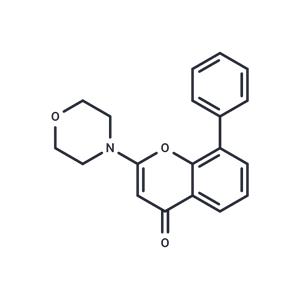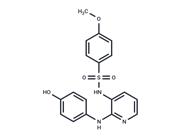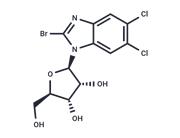| Name | LY294002 |
| Description | LY294002 (SF 1101) is a broad-spectrum inhibitor of PI3K, inhibiting PI3Kα, PI3Kδ, and PI3Kβ (IC50=0.5/0.57/0.97 μM). LY294002 is also an inhibitor of DNA-PK (IC50=1.4 μM) and an inhibitor of CK2 (IC50=98 nM). LY294002 activates apoptosis and autophagy. |
| Cell Research | The cells were seeded into 96-well plates at 5000 cells/well. Twenty-four hours after cells were seeded, the medium was removed and replaced in the presence of LY294002 (0 μmol/L, 10 μmol/L, 25 μmol/L, 50 μmol/L, and 75 μmol/L) dissolved in DMSO or DMSO only for an additional 24 h and 48 h. To avoid any nonspecific toxic effects of DMSO on cell growth, DMSO concentrations were maintained at 0.5% in all experiments. MTT dye (5 mg/mL) was added to each well. The reaction was stopped by the addition of DMSO, and optical density was measured at 490 nm on a multiwell plate reader. Background absorbance of the medium in the absence of cells was subtracted. All samples were assayed in triplicate, and the mean for each experiment was calculated. Results were expressed as a percentage of control, which was considered to be 100% [3]. |
| Kinase Assay | PI3K inhibition by LY294002 was determined in a radiometric assay using purified, recombinant enzymes (class IA and class IB) with 1 μM ATP. The kinase reaction was carried out for 1 h at room temperature (24 °C) and was terminated by addition of PBS. IC50 values were subsequently determined using a sigmoidal dose-response curve fit (variable slope). CK2 and GSK3β (glycogen synthase kinase 3β) inhibition were established by kinase selectivity screening. Inhibitor (10 μM; LY294002) was tested against the Upstate panel of kinases in 10 μM ATP [4]. |
| Animal Research | Athymic nude mice were used when they were 6-8 weeks. Mice were randomly divided into free separated into five groups (n = 4 mice). Mice were housed in the same environment with controlled temperature, humidity, and a 12 h light/dark cycle. Mice were inoculated subcutaneously with CNE-2Z cells (1 × 10^6 cells/mouse in 200 μl of RPMI-1640) into the flank. The tumor take rate was 100%. After 1 week, an intraperitoneal injection was performed to the xenograft mice with different dosage of LY294002 (10 mg/kg, 25 mg/kg, 50 mg/kg, and 75 mg/kg twice weekly (n = 4 mice), each group for 4 weeks. Treated mice have monitored any signs. Body weight and tumors size were measured twice a week. Tumor size was measured using calipers and tumor volume was calculated (volume = long axis × short axis^2). At the end of the treatment, all mice were euthanized. One part of tumor tissue was fixed in formalin and embedded in paraffin, and another part was stored at -70°C [3]. |
| In vitro | METHODS: Human pancreatic cancer cells AsPC-1, BxPC-3 and PANC-1 were treated with LY294002 (5-45 µM) for 24 h. Cell growth inhibition was detected by MTT.
RESULTS: LY294002 dose-dependently induced the growth of AsPC-1, BxPC-3 and PANC-1 cells with IC50 of 40 μM, 5 μM and 35 μM, respectively.[1]
METHODS: Chinese hamster ovary cells CHO-IR expressing human insulin receptor were treated with LY294002 (5 µM) for 5 min and stimulated with Insulin (1 nM, 10 min), and the expression levels of target proteins were detected by Western Blot.
RESULTS: LY294002 blocked insulin-induced phosphorylation of PKB Ser473 in CHO-I R cells. [2]
METHODS: Human nasopharyngeal carcinoma cells CNE-2Z were treated with LY294002 (10-75 μmol/L) for 24-48 h. Apoptosis was detected by Flow Cytometry.
RESULTS: LY294002 dose-dependently induced apoptosis in CNE-2Z cells. [3] |
| In vivo | METHODS: To detect anti-tumor activity in vivo, LY294002 (25 mg/kg twice weekly) and cisplatin (5 mg/kg once weekly) were intraperitoneally injected into BALB/C nu/nu mice harboring human pancreatic cancer tumor AsPC-1 for three weeks.
RESULTS: Tumor volume increased in the control mice, while the cisplatin or LY294002 treatment groups showed a 77% and 70% reduction in tumor volume, respectively. The combination treatment group was more effective, with tumor volume growth decreasing to 44% of the control group's volume. [4]
METHODS: To investigate whether pharmacological blockade of PI3K could ameliorate the development of LPS-induced acute liver injury in mice, LY294002 (40 μM; 10 μL) was administered by single intraperitoneal injection to the LPS-induced acute hepatic injury BALB/c mouse model.
RESULTS: In LPS-induced hepatitis, LY294002 treatment markedly inhibited the intrahepatic synthesis of various disease-associated pro-inflammatory cytokines, including tumor necrosis factor-α, IL-6, IL-1β, and INF-γ. Significant inhibition of IκB phosphorylation was observed in liver samples from LPS-injured mice with LY294002. Therefore, LY294002 may protect the liver from LPS-induced injury by inhibiting the IκB nuclear factor κ light chain enhancer of the activated B cell-dependent signaling pathway. [5] |
| Storage | Powder: -20°C for 3 years | In solvent: -80°C for 1 year | Shipping with blue ice. |
| Solubility Information | Ethanol : 10 mg/mL (32.5 mM)
10% DMSO+40% PEG300+5% Tween 80+45% Saline : 3.4 mg/mL (11.06 mM), Please add co-solvents sequentially, clarifying the solution as much as possible before adding the next one. Dissolve by heating and/or sonication if necessary. Working solution is recommended to be prepared and used immediately.
H2O : < 1 mg/mL (insoluble or slightly soluble)
DMSO : 61.46 mg/mL (200 mM), Sonication is recommended.
|
| Keywords | NSC-697286 | Lysophosphatidic acid | Leptin | NPC | NSC697286 | PI3K | DNA-PK | broad-spectrum | Autophagy | Phosphoinositide 3-kinase | DNA-dependent protein kinase | CNE-2Z | SF1101 | reversibly | Inhibitor | inhibit | YAP | translocation | Casein Kinase | LY-294002 | carcinoma | LY294002 | nasopharyngeal | spermatozoa | Human | Apoptosis | nuclear | tumor | SF-1101 |
| Inhibitors Related | Stavudine | 5-Fluorouracil | Sodium 4-phenylbutyrate | L-Ascorbic acid | Hydroxychloroquine | Guanidine hydrochloride | Taurine | Tributyrin | Curcumin | Paeonol | Naringin | Gefitinib |
| Related Compound Libraries | Bioactive Compound Library | Kinase Inhibitor Library | Anti-Cancer Metabolism Compound Library | Inhibitor Library | Anti-Prostate Cancer Compound Library | Anti-Aging Compound Library | Bioactive Compounds Library Max | Anti-Cancer Compound Library | Anti-Cancer Active Compound Library | Oxidation-Reduction Compound Library |

 United States
United States



